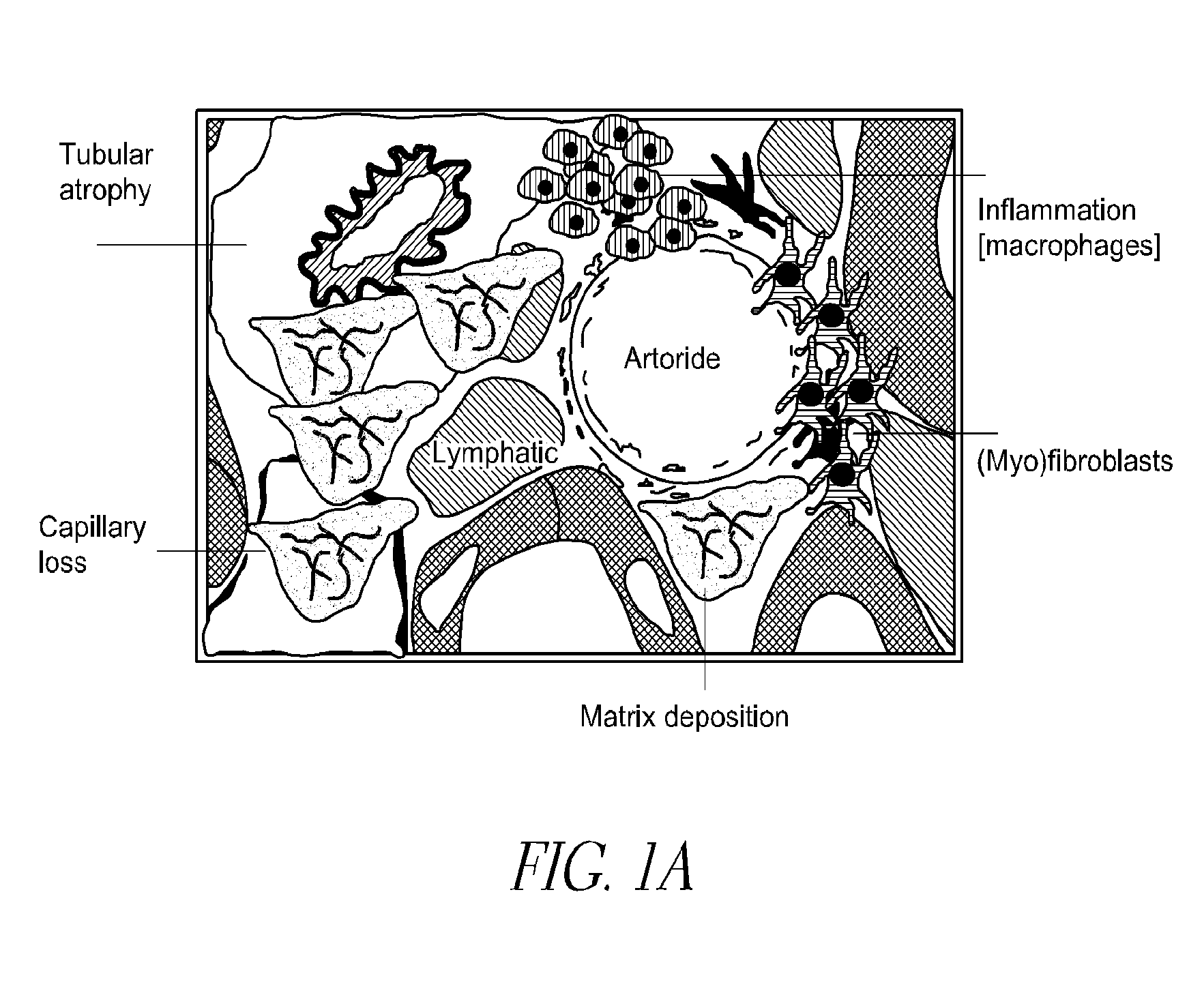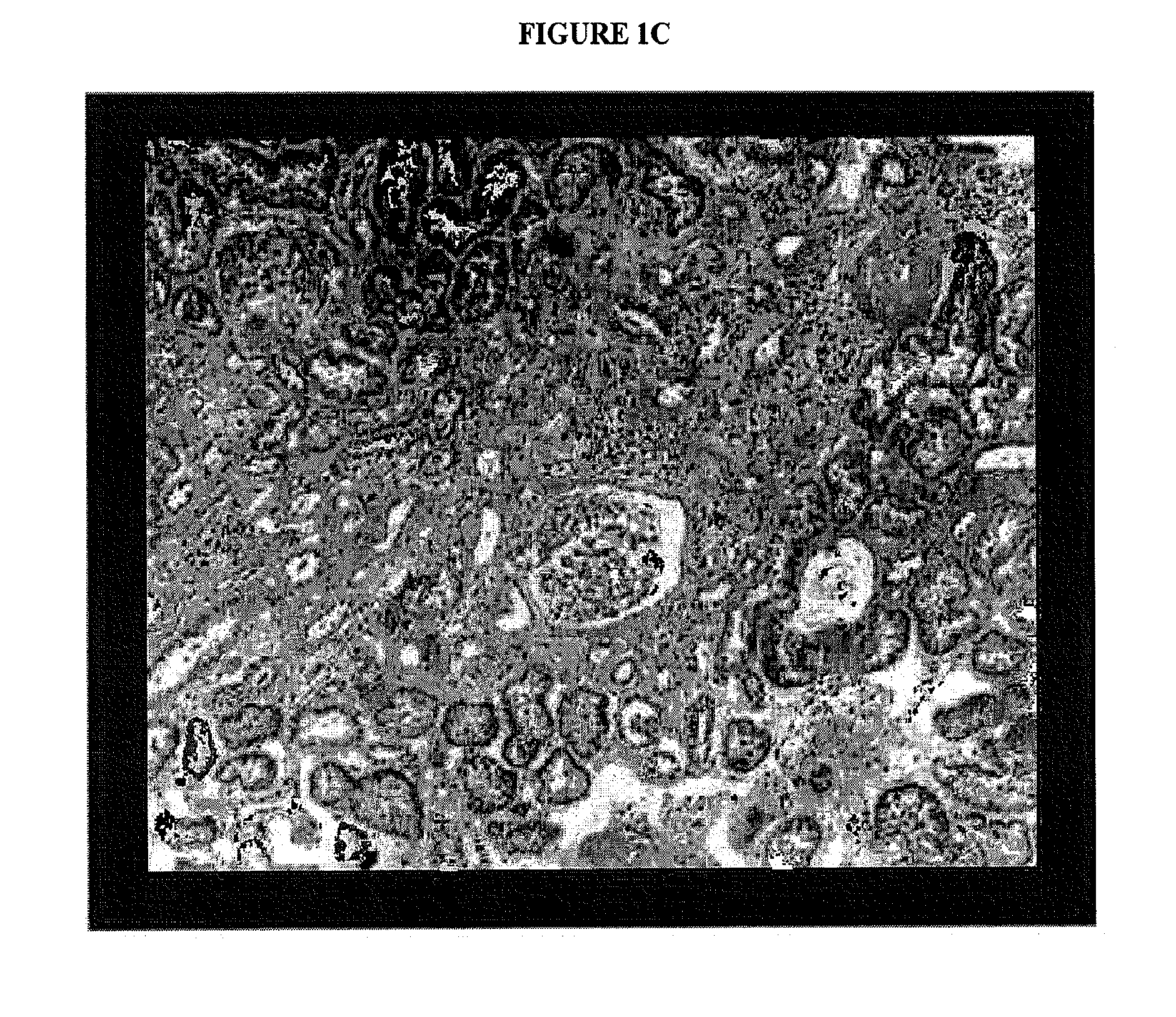Cysteamine in the treatment of fibrotic disease
a fibrotic disease and cysteamine technology, applied in the field of cysteamine in the treatment of fibrotic disease, can solve the problems of affecting most body systems, fibrotic diseases are unknown or poorly understood, and buildup of fluid and waste products, so as to prevent interstitial fibrosis
- Summary
- Abstract
- Description
- Claims
- Application Information
AI Technical Summary
Benefits of technology
Problems solved by technology
Method used
Image
Examples
example 1
IP Cysteamine HCl Dose Trial
[0099]Unilateral ureteral obstruction (UUO) was performed on ten mice. Starting on the day of UUO, two of the mice were given daily intraperitoneal (IP) injections of phosphate buffered saline (PBS), two of the mice were given daily intraperitoneal (IP) injections of 100 mg / kg freshly mixed cysteamine HCL in PBS, and two of the mice were given daily intraperitoneal (IP) injections of 200 mg / kg freshly mixed cysteamine HCL in PBS. One group of mice (n=2) was given daily intraperitoneal (IP) injections of freshly mixed cysteamine HCL in PBS starting at a dose of 200 mg / kg on the day of UUO and the dose was gradually increased every two days to a maximum dose of 400 mg / kg. Another group of mice (n=2) was given daily intraperitoneal (IP) injections of 200 mg / kg freshly mixed cysteamine HCL in PBS starting 5 days after UUO (D5 200 mg / kg). Possible seizures and somnolence were observed in mice given cysteamine HCL immediately after surgery and several mice died...
example 2
Oral Cystagon® Dose Trial
[0100]UUO was performed on sixteen mice and placebo (n=4 mice) or 200 mg / kg cysteamine bitartrate dissolved in drinking water administered on the first day after UUO. It was assumed that an average 25 g mouse drinks 5 mLs of water per day; cysteamine bitartrate was diluted in water and prepared daily to provide 200 mg / kg, 400 mg / kg or 600 mg / kg. One group of mice (n=4) received 200 mg / kg cysteamine bitartrate dissolved in drinking water for fourteen days. In one group of mice (n=4), the dose of cysteamine bitartrate dissolved in the drinking water was increased every 2 days to a maximum of 400 mg / kg. In one group of mice (n=4), the dose of cysteamine bitartrate dissolved in the drinking water was increased every 2 days to a maximum of 600 mg / kg. No deaths or abnormal behavior was observed, even at high doses. Mice were sacrificed at day 14 after UUO and total renal collagen levels (μg hydroxyproline / mg) were measured. Total collagen in the tissue was calcula...
example 3
Cysteamine Treatment Reduces Severity of Fibrosis in UUO Kidneys
[0101]Unilateral ureteral obstruction (UUO) was performed on 8 week-old wild-type male mice on a C57BL6 background. The degree of renal fibrosis was investigated using two doses of cysteamine bitartrate: 400 and 600 mg / kg / day. Cysteamine bitartrate was added to drinking water that was freshly made every 24 h starting on the first day after UUO at 200 mg / kg and the dose was increased every 2 days until the maximum dosage was reached. It was assumed that an average 25 g mouse drinks 5 mLs of water per day; cysteamine bitartrate was diluted in water and prepared daily to provide 400 mg / kg or 600 mg / kg. The control group did not receive cysteamine bitartrate treatment. Groups of mice (n=8-10 mice per group at each time-point) were studied 3, 7, 14, and 21 days after the onset of chronic injury induced by UUO.
[0102]Total collagen was measured as hydroxyproline concentration in hydrolysates extracted from frozen normal (unobs...
PUM
| Property | Measurement | Unit |
|---|---|---|
| weight | aaaaa | aaaaa |
| time | aaaaa | aaaaa |
| time | aaaaa | aaaaa |
Abstract
Description
Claims
Application Information
 Login to View More
Login to View More - R&D
- Intellectual Property
- Life Sciences
- Materials
- Tech Scout
- Unparalleled Data Quality
- Higher Quality Content
- 60% Fewer Hallucinations
Browse by: Latest US Patents, China's latest patents, Technical Efficacy Thesaurus, Application Domain, Technology Topic, Popular Technical Reports.
© 2025 PatSnap. All rights reserved.Legal|Privacy policy|Modern Slavery Act Transparency Statement|Sitemap|About US| Contact US: help@patsnap.com



